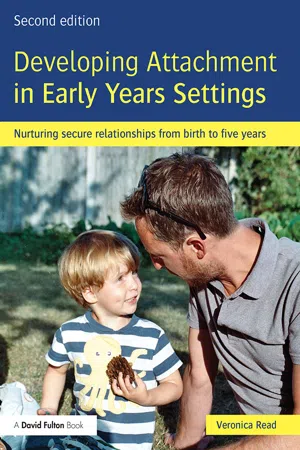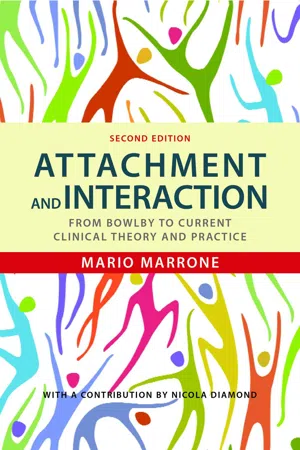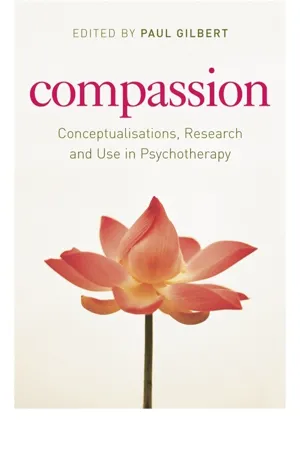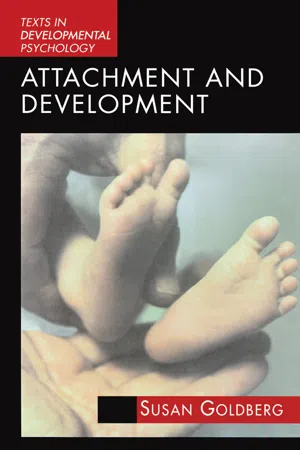Psychology
Attachment Figures
Attachment figures refer to individuals who provide a sense of security and comfort to others, particularly in early childhood. These figures are typically caregivers or parents who play a crucial role in a child's emotional development and sense of safety. The quality of the attachment relationship with these figures can have long-lasting effects on an individual's social and emotional well-being.
Written by Perlego with AI-assistance
Related key terms
7 Key excerpts on "Attachment Figures"
- eBook - ePub
Developing Attachment in Early Years Settings
Nurturing secure relationships from birth to five years
- Veronica Read(Author)
- 2014(Publication Date)
- Routledge(Publisher)
How does attachment research help us understand early childhood? There are many different ways of thinking about childhood. Attachment research focuses on the importance of good enough early relationships, as one of the most important building blocks for good emotional well-being and mental health in later life. When I use the term attachment I mean the unique relationship between a child and his primary carer that consists of numerous moment to moment interactions which foster future healthy development. It is important too that secondary attachment carers develop close and lasting relationships with the absent primary carer in order to successfully meet a child’s needs during that absence. Bowlby defines attachment behaviour as ‘any form of behaviour that results in a person attaining or maintaining proximity to some other clearly defined individual who is conceived as better able to cope with the world’ (Bowlby 1988). Many of our early experiences may be beyond our control, for example:- our genetic inheritance;
- the environment of the womb;
- when and where we were born;
- the social, economic and cultural circumstances of the family we are born into.
However our genes shape our future, we are all from the moment of birth dependent on others for our survival and so ‘a gene cannot express itself, or have an influence, without its intimate partner – the environment’ (Berry Brazelton and Greenspan 2000, p. xvii). We know now, too, that this very early social environment shapes our emotional development and lays down a model for future relationships. The quality of preparation that goes into the fostering of long-term secondary caring and the commitment to authentic shared nurturing is within the control of a society committed to the protection of children.Making relationships outside the familyStaff working in group childcare give a great deal of imaginative thought to the environments they create, by making them warm, inviting, exciting and interesting places to welcome children into. If you become really curious about how each child sees and experiences this world around them, then that will include being interested in how children relate to and experience you - eBook - ePub
Attachment and Interaction
From Bowlby to Current Clinical Theory and Practice Second Edition
- Mario Marrone(Author)
- 2014(Publication Date)
- Jessica Kingsley Publishers(Publisher)
This omission resulted in a certain ambiguity, for people’s fundamental need to find security in specific relationships was still explained in terms of feeding or sexuality. Although feeding and sexuality do play an important part in psychosocial life, they cannot easily account for the fact that attachment-related events and emotions play such a central role in human behaviour and early development.Intimate long-lasting relationships are seen in virtually all human beings, and they are commonly regarded as an integral part of human nature. There is more to it: (1) the strongest emotions, whether associated with joy or pain, emerge in the course of attachment-related events; (2) the quality and vicissitudes of the earliest relationships are determinants of personality development and mental health; and (3) the way people construe and manage relationships is based on previous experiences of relationships.If attachment is recognized as a primary motivational force with its own dynamics, then it may be easier to comprehend the far-reaching and complex consequences of attachment relationships. Otherwise, the understanding of attachment issues (particularly in their developmental and clinical implications) could only be assumed by making extrapolations from less compatible theoretical schemes.Bowlby explained that until the mid-1950s only one explicitly formulated view of the nature and origin of affectional bonds was prevalent, and in this matter there was agreement between psychoanalysts and learning theorists. It was assumed that interpersonal bonds develop because the individual discovers that, in order to satisfy certain drives, for example for food in infancy and for sex in adult life, another human being is necessary. This type of theory postulates two kinds of drive, primary and secondary; it categorizes food and sex as ‘libidinal’ or primary, and other personal relationships as secondary. The crux of attachment theory is that it assumes that the pains, joys and meaning of attachment cannot be reduced to a secondary drive. - eBook - ePub
Compassion
Conceptualisations, Research and Use in Psychotherapy
- Paul Gilbert(Author)
- 2005(Publication Date)
- Routledge(Publisher)
Bowlby (1988) viewed this behavioral system as extremely important for maintaining emotional stability, development of a positive self-image, and formation of positive attitudes toward relationship partners and close relationships in general. Moreover, because optimal functioning of the attachment system facilitates relaxed and confident engagement in non-attachment activities, it supports the operation of other crucial behavioral systems, such as exploration and caregiving, and thereby broadens a person’s perspectives and skills and fosters both mental health and self-actualization.In addition to mapping universal aspects and functions of the attachment behavioral system, Bowlby (1973) described important individual differences in attachment-system functioning. He viewed these differences as largely derived from reactions of significant others (caregivers, Attachment Figures) to a child’s attachment-system activation and from internalization of these reactions in attachment working models of self and others (i.e. mental representations, with associated emotional and behavioral tendencies). Interactions with Attachment Figures who are available and responsive in times of need facilitate optimal development of the attachment system, promote a sense of connectedness and security, and allow people to rely more confidently on support seeking as a distress-regulation strategy. In contrast, when a person’s Attachment Figures are not reliably available and supportive, a sense of security is not attained, and strategies of affect regulation other than proximity seeking (secondary attachment strategies, characterized by avoidance and anxiety - eBook - ePub
Child and Adolescent Psychology for Social Work and Allied Professions
Applied Perspectives
- Gabriela Misca, Peter Unwin(Authors)
- 2018(Publication Date)
- Bloomsbury Academic(Publisher)
➢ Why might Daniel’s mother not have shown protective behaviours and emotional warmth to Daniel? A major developmental milestone during the first year of life is that of forming stable and positive attachment relationships, and this in turn increases the effectiveness of parenting and socialization in later life. The rest of this chapter will explore why and how attachment develops and how the quality of the early attachment relationships influences later development.Emotional development and attachmentOur emotional development is largely determined by the early attachment relationship that we form with the main carer in our lives. Research evidence supports the idea that a stable and positive attachment relationship in early life is important for later emotional development and functioning (Morris et al., 2017). However, there have been various extrapolations of this relationship between early attachments and later development, and this chapter will explore the (re)formulated predictions of attachment theory as a much-used framework in social work practice.The lives of children known to social work teams are often very fragmented and lacking in stable friendships and relationships. The importance of emotional well-being for children is increasingly recognized, friendships early on in a child’s life helping build resilience and well-adjusted adults (e.g., Foley & Leverett, 2008). Friendships are particularly important for young children because they allow them to learn to be resilient and develop skills in relationships, such as cooperation. There is an obvious difficulty for children who have fragmented family backgrounds, particularly those in the care system who are often not in a single place for long enough to allow themselves to make attachments with too many people (Sinclair et al., 2005). This lack of attachment is then associated with a range of other problems – for example, emotional problems, poor cooperative play and a tendency for conflict, poor sociability, and poor school adjustment. For children who come into the care system with the accumulated needs of a lifetime of distress, uncertainty, inconsistency and confusion, the primary aim of all significant adults should be to provide them with positive experiences and opportunities. Social workers hold key historical knowledge about the children with whom they work and need to use this knowledge in ways that help a child make sense of their world and promote emotional well-being and resilience. - eBook - ePub
Attachment Theory
Social, Developmental, and Clinical Perspectives
- Susan Goldberg, Roy Muir, John Kerr(Authors)
- 2013(Publication Date)
- Routledge(Publisher)
1988b ) summary evaluation of where attachment research stands: “A major conclusion is that, whatever influence variations in genetic endowment may exert on personality development and psychopathology, an immense influence is unquestionably exerted by environmental variables of the kinds now being systematically explored” (p. 2).Cultural Contexts of Attachment
Mary Ainsworth once admitted that her first empirical tests of Bowlby’s ideas did not totally convince her until she started to work in Uganda in 1953–54. A pivotal reason for her determination to undertake a cross-cultural study is that attachment theory takes a very strong stand on optimal conditions for secure attachment with a specific subtype of secure babies (B3) considered to be most securely attached–regardless of culture.Dunn (1993 ) has pointed out that attachment relationships are not the only important relationships the developing child has. Nor, from a cultural perspective, do relationships stand alone in shaping development. Relationships, play, art, aesthetics, and a host of other culturally shaped variables all need to be considered. This is obviously true. However, one need not concede that attachment relationships are but one type among many nor that they are superseded by other facets of a given culture in shaping development. To the contrary, the nature of the attachment bond contributes a distinct and fundamental psychological quality to experience that affects how many other experiences will be assimilated and integrated by the growing individual. Insofar as secure attachment favors autonomous and self-determined exploratory and playful behavior, it sets the stage for a smooth development into the world of cultural values—and as with the child, so with the adult. The ability to participate fully in cultural rituals and to take advantage of cultural assets is correlated, to no small degree, with one’s esteem for the lives of others who belong to the same society. Minsky (1987 ) has written from an information-processing perspective that an important goal is to learn goals worth pursuing; attachment is such a superordinate, organizing goal. When basic attitudes toward attachment change, many other features of childhood are bound to change, too, including peer relationships, concentration, satisfaction, and coping (see Suess, Grossmann, and Sroufe, 1992 ; Grossmann et al., 1993 ). Wensauer (1994 - eBook - ePub
- Susan Goldberg(Author)
- 2014(Publication Date)
- Routledge(Publisher)
Sroufe, 1997 ) is that of the branches of a tree. One may arrive at many different end points from a given starting point, and there are opportunities to cross from one main limb to another via smaller branches. However, the further out one moves on a particular limb, the less likelihood there is of crossing over to other limbs. Thus a particular infant attachment pattern does not determine the end point but weights the likelihood of reaching one end point compared to another.Mother blaming'
A common complaint regarding attachment theory is that it unfairly continues a tradition of blaming mothers unduly for their children’s successes and failures (e.g. Chess and Thomas, 1982 ). Bowlby himself sometimes spoke broadly, referring to a ‘principal attachment figure,’ and other times more narrowly of the ‘mother’, but in fact, as we noted in Chapter 6 , most of the research has been done with mothers. The ‘over-representation of mothers’ in research and theory reflects the fact that, despite an increasing emphasis on shared parenting, mothers are still ‘over-represented’ among the primary caregivers of young children. As a result, however, much of the literature repeatedly refers to mothers when the concepts and ideas could also apply to other Attachment Figures.Nevertheless, since mothers are the primary caregivers of infants in most families, the care they provide for infants and young children is important for development. Such an assertion does not necessarily ‘blame’ mothers. Most parents want the best for their children and make every effort to do the best job they can under the conditions that they face. Through studies of adult attachment and attachment under adversity, we have started to appreciate how the experiences, context, and resources of some mothers compromise their ability to be the parents they would like to be. Research on attachment as well as related domains in child development has enabled us to appreciate the complexity and power of the factors that impinge on parents’ abilities to care for young children. We have considered some of these in Chapter 8 - eBook - ePub
Parenting
What Really Counts?
- Susan Golombok(Author)
- 2014(Publication Date)
- Routledge(Publisher)
3 Children may become attached to one or a few specific individuals, usually in a clear order of preference, and the more a person interacts with an infant the more likely that infant is to become attached to that person. Thus whoever is most involved in looking after the child will become the main attachment figure, and the child will turn to the others when the main attachment figure is not there. More than any other person, John Bowlby has helped us to understand the nature of parent—child relationships, and the ways in which experiences with parents can influence children's psychological development from childhood through to adult life.Although Bowlby trained as a psychoanalyst and was convinced of the importance of children's relationship with their mother for their future psychological development, he soon came to believe that it would be more informative to study what actually happened to children than what went on in their unconscious minds. His ideas originated from his studies of children who had been separated from their mother. Such children, he found, became very distressed in the short term and, after prolonged separation, showed extremely disturbed behaviour. He was particularly interested in children taken into hospital who, in the 1940s and 1950s when Bowlby was studying them, were allowed little contact with their parents. Bowlby observed that these children all responded in a similar way: at first they made a fuss, and when this failed they gave up in despair; and finally they entered the stage of detachment when they appeared not to care. The longer the spell away from home the more long-lasting were the effects of separation. The heart-rending film made by Bowlby's colleague James Robertson of these children being left by their parents on hospital wards points to just how devastating such separations can be. Further evidence for the negative effects of separating children from their parents came from Bowlby's classic study ‘Forty-four juvenile thieves: their characters and home life’, which described the inability of some of these young men to form affectionate relationships with anyone, a finding he associated with long periods of separation from their mother early in childhood.4
Learn about this page
Index pages curate the most relevant extracts from our library of academic textbooks. They’ve been created using an in-house natural language model (NLM), each adding context and meaning to key research topics.






